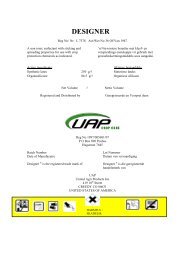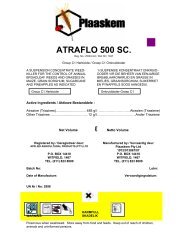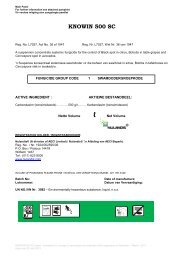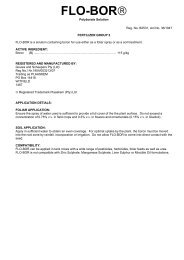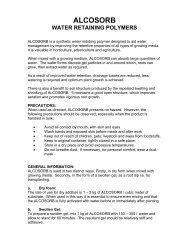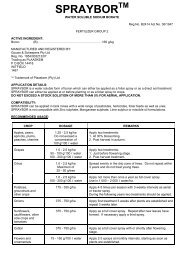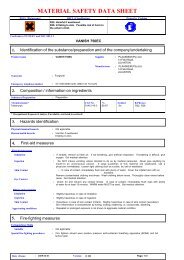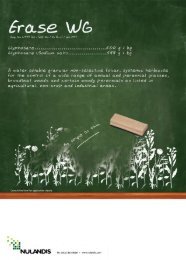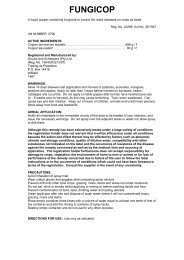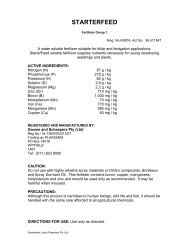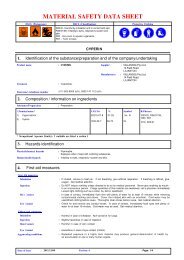CITRIMET 500 AL - Nulandis
CITRIMET 500 AL - Nulandis
CITRIMET 500 AL - Nulandis
Create successful ePaper yourself
Turn your PDF publications into a flip-book with our unique Google optimized e-Paper software.
Clean applicator after use with FLUSHSOL* and make sure that wash water does not contaminate grazing or<br />
drinking water.<br />
SYMPTOMS OF HUMAN POISONING:<br />
Headache, fatigue, faintness, giddiness, excessive sweating, nausea, abdominal pains, vomiting, diarrhoea,<br />
tightness of the chest, anxiety, blurred vision, muscle twitching (beginning in the eyelids and tongue), small pupils,<br />
respiratory distress, convulsions and coma.<br />
FIRST AID TREATMENT:<br />
Remove patient from source of poisoning to a cool and well-ventilated area and keep him quiet and reassured.<br />
Remove contaminated clothing and rinse contaminated body area thoroughly with plenty of soap and cold water. Do<br />
not rub the skin. Flush contamination out of eyes with clean water for at least 15 minutes. If concentrate has been<br />
swallowed, firstly give copious quantities of either beaten egg white, starch solution or Milk of Magnesia before<br />
inducing vomiting by tickling back part of the throat. Repeat until vomit is clear and free from the smell of poison.<br />
Take the patient immediately to the nearest physician. Administer artificial respiration or closed chest cardiac<br />
massage if necessary. Do not apply direct mouth–to-mouth respiration. Never give anything by mouth to an<br />
unconscious person.<br />
NOTE TO PHYSICIAN:<br />
Administer atropine sulphate (1 - 4 mg) intravenously every 5-10 minutes until first signs of atropinization (dry<br />
flushed skin and tachycardia), 2-PAM 50 mg/kg up to total dose of 1-2 mg, or 2/3 of this dose of Protopam. Repeat<br />
oximes if necessary. Do not give morphine.<br />
RESISTANCE WARNING:<br />
For resistance management, Citrimet <strong>500</strong> <strong>AL</strong> is a group 1B insecticide. Any insect population may contain<br />
individuals naturally resistant to Citrimet <strong>500</strong> <strong>AL</strong> and other group 1B insecticides. The resistant individuals dominate<br />
the insect population if these insecticides are used repeatedly. These resistant insects may not be controlled by<br />
Citrimet <strong>500</strong> <strong>AL</strong> or other group 1B insecticides, although local experts should be consulted for local resistance<br />
recommendations. The following classification scheme is based on mode of action. It is recognized that resistance<br />
of insects and mites to insecticides and acaricides can also result from enhanced metabolism, reduced penetration<br />
or behavioural changes that are not linked to any site of action classification but are specific for individual chemicals<br />
or chemical groupings. Despite of this, alternation of compounds from different chemical classes remains a viable<br />
management technique. To delay insecticide resistance:<br />
* Avoid exclusive repeated use of insecticides from the same chemical subgroup.<br />
* Integrate other control methods (chemical, cultural, biological) into insect control programs<br />
For further information contact your local distributor.<br />
DIRECTIONS FOR USE:<br />
Use only as directed.<br />
Do not apply <strong>CITRIMET</strong> on top of any other trunk treatment (i.e. PVA paint, ant barrier, ect.). Apply directly to the<br />
trunk surface. Phytotoxic symptoms {i.e. bark split (gummosis of bark)} may occur during January - March on<br />
Volckamoriana root-stocks in citrus, and sometimes in trees under stress. Ensure trees to be treated receive regular<br />
irrigation, are healthy and not stressed prior to application. Do not allow irrigation to come into contact with treated<br />
zone as a reduction in residual efficacy may occur.<br />
COMPATIBILITY:<br />
Do not mix with any other compounds.<br />
* Flushsol: Plaaskem Pty Ltd



